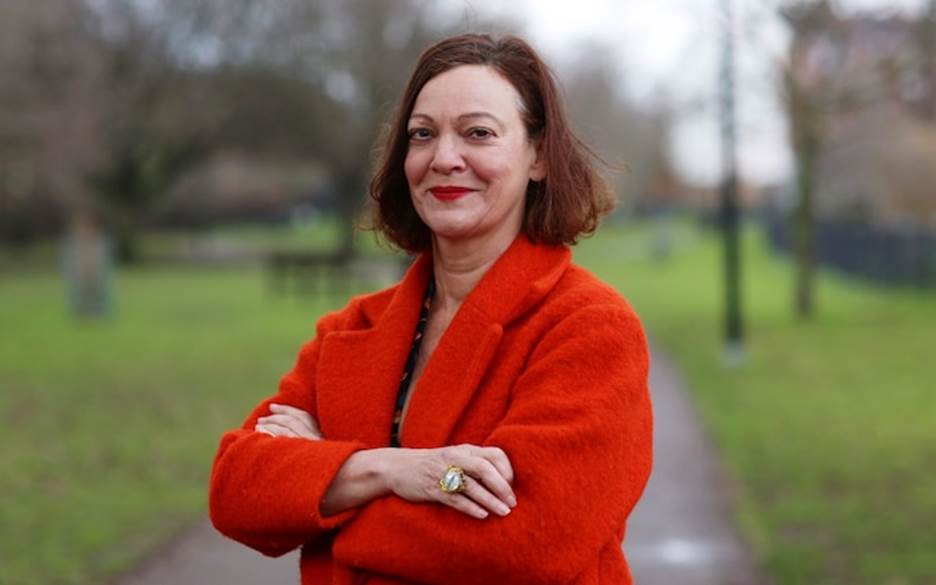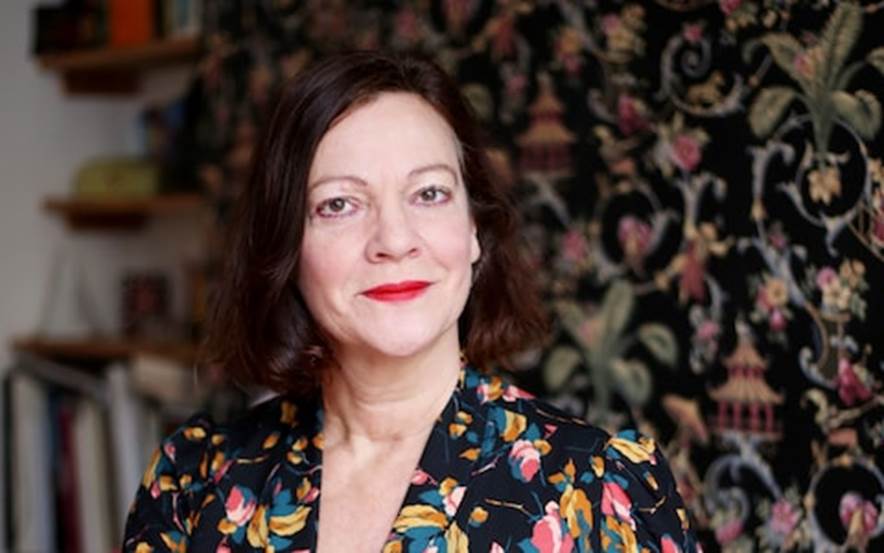
With a family history of heart disease, Liz Hoggard realized it was time to take her breathlessness seriously -Credit Clara Molden
How I’m Reducing My Heart Attack Risk – And You Can Too
By Liz Hoggard
I’m wheezing up a hill. Or maybe a slope. Furious, I collapse on a bench. My partner Mike eyes me nervously. “You should get your heart checked,” he says bluntly.
I bat his worries away. I walk 30 miles and swim three times a week, climb escalators, do pilates . I just hate hills – they’ve made me breathless since childhood.
Female friends tell me not to panic. No one likes hills in middle age. And Mike, a wiry Yorkshireman, can be slightly tyrannical about walking.
True, my diet has flaws. I live alone and during lockdown awarded myself two sweet treats a day (and then there’s the booze and my late-night Bombay Mix – I am a child of the 1970s after all).
So I’m fit but a little bit fat. In this body-positive age, that’s fine, surely?
Family history
But something nags. Heart health is terrible in my family. My father and all my grandparents died of heart attacks early in life. I’d assumed that would be my fate. Not now of course – nothing to see here – but years later. It might even be a kinder alternative to a long illness.
But when I do the math, it’s not looking good. A family history of heart disease is defined by having a first-degree male relative (father, brother) who had a heart attack by age 55, or a first-degree female relative (mother, sister) by age 65.
That would be me, then. My poor dad first had angina in his early 40s. He had a heart attack on holiday in Spain age 54. A triple heart bypass gave him a new lease of life. He gave up smoking and took up exercise. But 20 years later he died of a heart attack, after going out for afternoon tea and booking a holiday.
I never knew my paternal grandfather who died age 45 in 1953 (after taking part in the D-Day landings). It was devastating for my father, then 17, and his brother, 19, who were out at the cinema. Widowed at 41, my nana lived alone until she had a heart attack herself at age 79, a packed suitcase under her bed ready for her next holiday. An emblem of delayed gratification that breaks my heart.
On my mother’s side, my granny had a stroke in her early 70s. It left her semi-paralyzed (terrible for a strong woman). She lived a half-life until she died of heart failure age 92, seven years after her husband, my grandpa, who died of heart disease at 85.
For years I was in denial. It’s just our genetic lottery, I told myself. My relatives lived full lives (mostly) and were still planning treats to the end. But actually, when you reach a milestone birthday (I was 60 in August), dying at 74 doesn’t seem far off.
My mum is slim and elegant at 86. But my middle sister (I’m the eldest of three) was diagnosed with a cardiac arrhythmia in her 30s and conscientiously takes medication every day. Should I be doing more to reduce my risk, too? When I look at the family album, the gaps are painful.
Coronary artery disease is the leading cause of death worldwide. And statistics show that excess deaths from heart attacks have skyrocketed in the UK since the pandemic, with reduced access to emergency services. Sir Chris Whitty, the Government’s chief medical adviser, is worried too many people are dying from strokes and heart attacks because they missed out on treatments for high blood pressure.
And it’s not just about treating blood pressure. You need to be assessed for other risk factors for an early stroke or heart attack, such as age, cholesterol levels and family history, using a calculator like QRISK3, which calculates a person’s risk of developing a heart attack or stroke over the next 10 years.
Health check
I visit my GP who takes my breathlessness seriously. My blood pressure is only slightly elevated but she sends me to King’s College Hospital for a baseline health check – everything from an ECG to cholesterol, liver and thyroid tests. “Everyone should have them at 60,” she says briskly.

Liz's GP sent her to King’s College Hospital for a baseline health check after observing her blood pressure was slightly elevated - Credit: Clara Molden
At hospital, I feel a fraud as I sit among truly ill people.
The results come back. Apart from sky-high vitamin D levels (Covid!), my surgery isn’t worried. Still, I push for my notes – and a phone consultation. The GP says my ECG was fine, my bad cholesterol (LDL) is a bit high, but that’s balanced by the good cholesterol (HDL).
However, my GP adds, my HbA1c reading (a blood test measuring blood sugar levels) is 41, a point away from being prediabetic (a reading over 42).
That’s a shock. My dad had type 2 diabetes before he died, my slim mum is prediabetic.
But my overall QRISK is 8.4 (it should be under 10). So, all good. “Nothing to worry about,” I tell Mike.
But when I consult Prof Kausik Ray, a leading consultant cardiologist, and president of the European Atherosclerosis Society, he’s less impressed. My ECG test merely tells him I haven’t had a heart attack or heart rhythm disturbance.
“You’re younger and female so your QRISK of having a heart attack or stroke will be 8.4 per cent over 10 years, but in five years’ time, with your diet and lifestyle, your risk is going to be above 10, and you’ll be recommended to go on statins as your risk is more than 10 per cent over 10 years.”
Action stations
If I don’t act now, it could mean years of bad health, Prof Ray tells me honestly. He’s pleased I exercise, but to burn off what I eat I’m “going to have to do a hell of a lot in terms of exercise”.
And the villain is cholesterol in the walls of the blood vessels, a process that starts within the first decade of life and progresses over time. My total (serum) cholesterol score is 6.7mmol/L (ideally it should be 5mmol/L). Yes, I have a high level of good cholesterol (it tends to be higher in women) but this won’t necessarily compensate for the other risk factors.
Statins help lower bad cholesterol (LDL) in the blood. They reduce the amount of cholesterol laid down in the wall and stabilize plaques and furring up the arteries. But they can’t instantly reverse a process that has been going on for decades.
The heart is like a boiler. “You can have a problem with the pump [the muscle] and you can have different problems with the valves [leaking or narrowing] straining the heart muscle. It could be a problem with the pipes, they could get scaled and furred up. But if we narrow it down to your risk of a heart attack, essentially the process that leads to the attack part is a blood clot forming on the lining of one of the three major blood vessels that supply the heart.
“And this doesn’t happen overnight. We think of age as a risk factor, but it’s just the number of years you’ve been exposed to everything else, on a background of inherited vulnerability to all that you are exposed to,” explains Prof Ray.
The key is to target and slow down the lifelong accumulation of cholesterol in the walls of our blood vessels. We’re back to plumbing metaphors. “When it gets blocked that’s not the time to put in the drain cleaner,” he admonishes. “That’s the time to call the plumber. That’s what you do with a heart attack. You go to hospital and somebody unblocks it. But whether it’s going to get blocked again depends on how much drain cleaner – i.e., medication and a low-fat diet – you continue to put down it thereafter.”
The good news is that for every one unit the LDL cholesterol comes down, risk of a heart attack decreases by 22 per cent. Weight loss would lower my triglycerides (a fatty substance similar to bad cholesterol) and push up my good cholesterol level, and my blood pressure would come down more.
“So, you’re offsetting some of the causal factors that accelerate that furring up of the blood vessels,” says Prof Ray. Though technically all cholesterol is bad.
My Bombay Mix and weekly chips habit needs a rethink. The main driver of prediabetes is weight, he tells me. Waist size matters. For women, post-menopause, when the gender advantage is slowly lost, the risk of a heart attack jumps. Over time, high blood sugar can damage blood vessels, the heart muscle directly as well as the kidneys.
“Your body becomes resistant to insulin with increases in weight, so even though you have normal blood sugar levels, the pancreas pumps out more insulin. That keeps blood sugar levels relatively normal, but as the levels creep up, the pancreas can’t produce enough, and you drift towards diabetes. The only way, really, is weight loss, ideally with diet and lifestyle changes, but medications if needed.”
Putting the work in
The hard work starts. I’ve cut out sugar and learned to love zero-alcohol beer. As well as downloading a hypnosis app to target binge eating, I now cook from scratch. And I’ve invested in an Omron M4 Intelli IT blood pressure monitor that links to my phone and shoots up scarily after I have a bottle of wine with a friend in a restaurant.
The more alcohol you drink the higher the risk of developing hypertension (high blood pressure). It even admonishes me after a biscuit. Not only does sugar help pack on the pounds, but it independently impacts blood pressure.
Prof Ray still thinks I should still check out the root cause of my breathlessness. He advises I ask my GP for an echocardiogram (an ultrasound scan, which will tell me if the heart muscle and valves are OK, but a CT scan will be needed to see if I have furring in my arteries supplying the heart).
“With an increase in oxygen demand during exercise, the heart muscle has to work harder. If there is narrowing in the blood vessels, during exercise the supply of oxygen doesn’t match demand.”
I will always have a higher predisposition to heart attacks. I can’t change the genes, but I can change the environment and offset that vulnerability. “It’s like you’re at the top of a mountain ski slope,” says metaphor-loving Prof Ray. “You see the danger at the bottom. If you course-correct early you’re going to miss it by a mile. If you only see it with 10 meters to go, you’ll have to course-correct a lot.”
Talking of slopes, with my tweaked diet, I am finding hills easier. If I’ve learnt one lesson, it’s not to bury your head in the sand. Mike was frustrated with me because he’d like me to stay alive.
I owe it to my relatives to be more grown-up. They would have loved to have had my choices. – Telegraph

